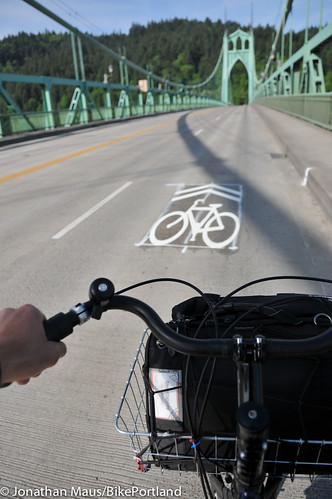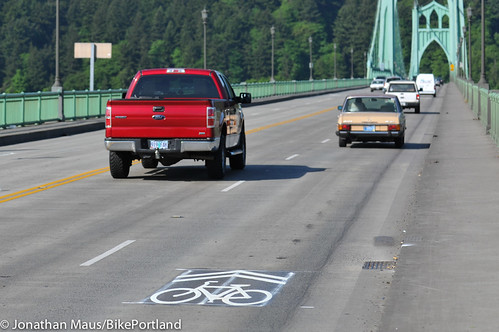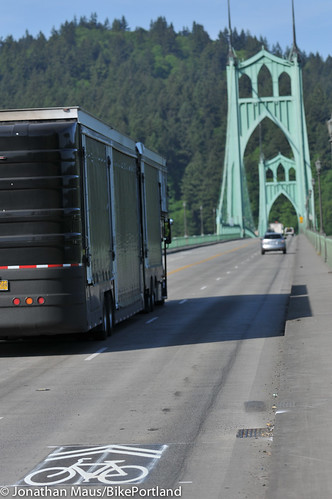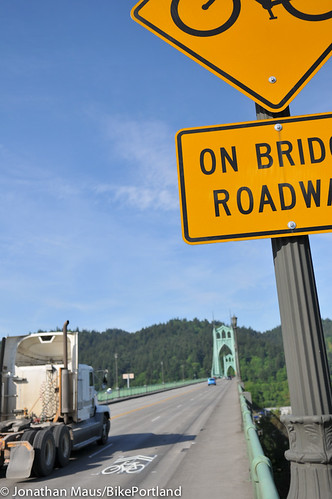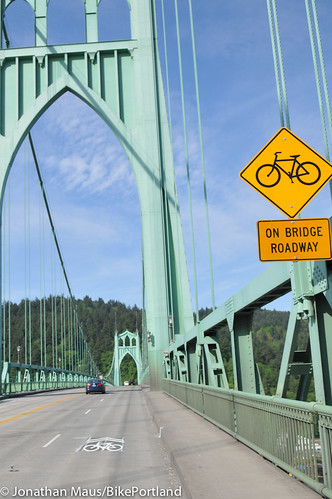On Saturday night, the Oregon Department of Transportation installed sharrows and new signs on the St. Johns Bridge. Their “St. Johns Bridge Safety Awareness Project” was done in order to, “encourage motorists to be aware that the bridge and roadway is a shared facility and that bicyclists may opt to travel on the roadway.”
They have placed eight sharrows in each direction, as well as adding two new “Bicycles on Roadway” signs mid-span. They also moved an existing sign at the westbound entry to a more visible location because it was partially blocked by a speed sign.
I rolled out to see everything myself this morning. My impression is that, while it’s nice to see ODOT acknowledge the bike access problems on this bridge, these sharrows and signs do not make this a more pleasant place to ride. Then again, that was not ODOT’s mission. As the name of the project implies, the new markings and signs will only increase awareness that people have the legal right to ride bicycles on the bridge. That’s helpful, but it’s a far cry from what should be the ultimate goal — to make the bridge a more viable (and less stressful) option for people on bicycles.
As I stood on the sidewalk to snap photos, massive trucks boomed by at well over 30 miles an hour (the speed limit is 35 mph, above which Oregon’s unsafe passing law goes into effect). The bridge shook beneath my feet and the sound pierced my ears. I usually ride this bridge on the weekend, when traffic (especially big trucks) is much more tame. I have taken a lot of photos while biking in traffic over the years, but I seriously considered aborting my mission this morning.
Against this intimidating backdrop of four lanes of roaring engines, sharrow markings look a lot different than they do on a quiet residential street.
To actually make the St. Johns Bridge a place where more people would consider bicycling, the solution would be to have a protected bike lane and one standard lane in each direction. That was actually the recommendation made by consultants David Evans & Associates, who studied the bridge in 2003.
“Result of traffic operations analysis in 2002,” read DEA’s St. Johns Bridge Transportation Impacts report (PDF), “indicates no capacity constraints or operational flaws on the bridge that would prohibit the implementation of any of the striping options.” Even in 2020, the report found that the only bottlenecks that would occur would be at the signalized intersections on each end.
Despite this study, and despite some advocacy by the Bicycle Transportation Alliance and others, ODOT caved to the freight lobby and left the lanes as-is. Hopefully, this small step by ODOT is just the start of a new conversation.
There wasn’t any other bike traffic this morning that took the road (I saw two people up on the sidewalk), so I couldn’t judge how people in cars behaved around the new markings.
Check out a few more photos below…


